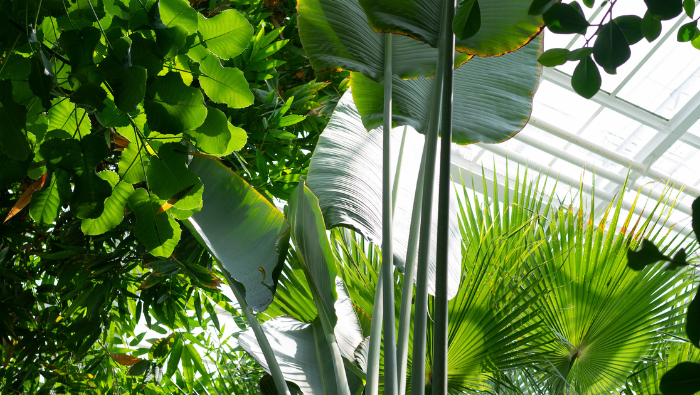Palm House
Palm trees were considered the epitome of the tropics at the time of the garden’s founding in Europe. It was customary at the time for the tallest and largest glass house to be dedicated to palms along with other heat-loving exotics: The Palm House (Hall B) provides ample space for tall-growing tropical plants to flourish under a spacious dome 21 feet high.
Slender palms, overgrown with lush green arum plants, define the character of the Palm House, which offers a realistic image of the tropical jungle. Banana shrubs display their drooping inflorescences with rows of young pencil-shaped bananas below large brown-purple bracts. Vines reach upward, all manner of aerial roots dangle down, while sturdy stilt roots anchored in the ground support a large screw tree (Pandanus balfourii). Nearby, the fruit bulb of the Panama palm (Carludovica palmata), opening in arching strips, green on the outside, orange-red on the inside, glows on the jungle floor. If you follow the first cross path to the northern end, you will come to two special plant sights: the leather mantle tree (Coccoloba pubescens) with its huge, soft-haired leaves can provide protection from both sunlight and tropical downpours in the Caribbean. Another star of the Palm House is the giant bamboo (Dendrocalamus). A pointed brown-scaled cone, the young shoot pushes out of the ground and stretches mightily in the first days of its life. 20 to 30 centimeters, on good days even up to half a meter, the bamboo shoot can grow per day.
Various tree- and shrub-like fig species, typical of all tropical forests on earth, complete the jungle picture. On the north wall of the Palm House, one discovers a well-known houseplant in oversized formation, also equipped with supporting roots: the birch fig (Ficus benjamina). Climbing arum plants such as the window leaf (Monstera deliciosa), which is often kept as a houseplant, can also be seen there.




